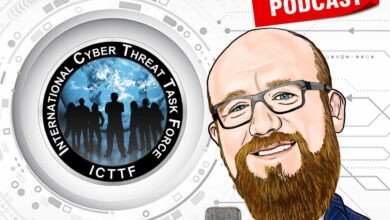
Hackers Target SSNs A Shifting Threat
Hackers now prefer social security numbers to credit card numbers, raising serious concerns about the evolving tactics of cybercriminals. This shift highlights a crucial vulnerability in our current security landscape, prompting us to explore the motivations, technical implications, and societal impact of this dangerous trend. Understanding why and how hackers are targeting SSNs is vital to protecting ourselves and our financial well-being.
The motivations behind this shift are multifaceted, ranging from the financial gain of selling stolen identities to the potential for data exfiltration and identity theft. This shift isn’t just about numbers; it’s about a sophisticated adaptation to existing security measures and a focus on exploiting a more sensitive data point. The comparative value and exploitability of SSNs versus credit cards are key factors in this shift, and the potential for secondary exploitation is a major concern.
Motivations Behind the Shift
The recent shift in hacker priorities, favoring Social Security Numbers (SSNs) over credit card numbers, signals a significant change in the cybercrime landscape. This trend warrants careful examination to understand the underlying motivations and potential consequences. Hackers are increasingly targeting SSNs due to their unique value in facilitating identity theft and financial fraud.The perceived value of SSNs has risen dramatically in the cybercriminal world.
This heightened value stems from the intricate web of financial and personal implications associated with compromised SSNs. The motivations behind this shift are complex and multifaceted, reflecting the ever-evolving nature of cybercrime.
Potential Motivations for the Shift
The shift towards targeting SSNs over credit cards is driven by a combination of factors, including the increased difficulty in exploiting credit card numbers and the higher potential rewards associated with SSN compromise.
- Financial Gain: SSNs are crucial for opening accounts, securing loans, and accessing various financial services. Successfully obtaining an SSN allows hackers to potentially exploit these financial avenues, leading to substantial financial gains. A stolen SSN can be used to open fraudulent accounts, apply for loans in the victim’s name, or make unauthorized purchases, generating significant illicit profits.
- Data Exfiltration: SSNs are highly sensitive identifiers linked to extensive personal data. Compromising an SSN opens the door to accessing vast amounts of associated information, such as addresses, dates of birth, employment history, and medical records. This detailed information can be used for various nefarious purposes, including identity theft and targeted phishing campaigns.
- Identity Theft: The most significant motivation is the potential for extensive identity theft. With a compromised SSN, hackers can assume the victim’s identity, leading to significant financial and reputational damage. This includes opening fraudulent accounts, obtaining loans, and making purchases under the victim’s name, while simultaneously evading detection through sophisticated techniques.
- Secondary Exploitation: SSNs enable hackers to access a wider range of services and opportunities compared to credit card numbers. Once an SSN is compromised, it can unlock access to various accounts, leading to secondary exploitation. This includes accessing bank accounts, insurance policies, and even government benefits, which are often linked to SSNs.
Comparative Analysis of Value and Exploitability
The perceived value and exploitability of SSNs and credit cards differ significantly in the current cyber landscape. The ease and frequency of credit card fraud detection, coupled with robust security measures, have made credit card numbers less attractive.
Hackers are increasingly targeting social security numbers instead of credit card details, making personal identification information a prime target. This shift in tactics highlights the need for robust security measures, like the Department of Justice’s recent Safe Harbor policy for Massachusetts transactions, Department of Justice Offers Safe Harbor for MA Transactions. While this initiative offers some protection, the underlying issue remains: hackers’ preference for social security numbers, potentially leading to significant financial and personal harm.
| Factor | SSN | Credit Card |
|---|---|---|
| Value | High: Enables access to extensive personal and financial information, including identity theft and significant financial gain. | Medium: While valuable, credit card fraud detection mechanisms and security measures make them less exploitable. |
| Exploitability | High: Easier to convert into significant financial gain and to utilize for sophisticated fraud. | Medium: Detection is more readily available and security measures are in place. |
| Secondary Exploitation | High: Can lead to access to numerous services and accounts, facilitating complex and wide-ranging fraudulent activities. | Medium: While potentially exploitable, the scope of secondary exploitation is often limited. |
Likely Reasons for the Shift
The shift towards SSNs as the preferred target reflects a complex interplay of factors. The evolving cybercrime landscape, coupled with advancements in hacking techniques, is driving this trend.
Technical Implications of the Shift

The increasing preference among hackers for Social Security Numbers (SSNs) over credit card numbers signifies a crucial shift in cybercrime tactics. This shift isn’t merely a trend; it reflects a calculated change in how attackers approach data breaches, leveraging the unique vulnerabilities and consequences associated with SSNs. Understanding these technical implications is paramount for both individuals and organizations to effectively mitigate risks.The use of SSNs by hackers differs significantly from their use of credit card numbers.
Credit card numbers are primarily valuable for financial gain. In contrast, SSNs offer access to a broader spectrum of sensitive information, including identity theft, opening fraudulent accounts, and accessing government benefits. This expanded potential for harm, beyond mere financial loss, makes SSNs an attractive target for sophisticated cybercriminals.
Differences in Attack Vectors
The methods hackers employ to target SSNs differ from those used for credit cards. Hackers leverage various attack vectors to acquire SSNs, including phishing scams, malware, and social engineering tactics.
| Attack Method | Description | Example |
|---|---|---|
| Phishing | Sophisticated emails or messages that appear legitimate, tricking individuals into revealing personal information, including SSNs. | A seemingly official email from a government agency requesting SSN verification. |
| Malware | Malicious software installed on a computer or device without the user’s knowledge, often used to steal data. | Keyloggers capturing SSN input during online transactions. |
| Social Engineering | Manipulating individuals into divulging sensitive information through psychological tactics. | A phone call pretending to be from a bank, asking for SSN verification. |
Consequences of SSN Breaches
The consequences of successful SSN breaches are far more severe than credit card breaches.
| Consequence | SSN Breach | Credit Card Breach |
|---|---|---|
| Financial Ramifications | Potential for significant financial loss, including fraudulent accounts, identity theft, and the denial of legitimate services. | Limited to financial losses related to the stolen credit card. |
| Reputational Damage | Severe damage to reputation, making it difficult to rebuild trust and access credit. | While reputational damage is possible, it is typically less severe than with SSN breaches. |
| Legal Ramifications | Potential legal issues, including lawsuits and criminal charges for identity theft and fraud. | Legal ramifications are usually limited to financial disputes. |
Technical Hurdles in Protecting SSNs
Protecting SSNs against theft presents significant technical challenges compared to credit card information. SSNs are often embedded in crucial documents and systems, making them harder to isolate and secure.
Security Measures for Credit Cards vs. SSNs
The security measures used to protect credit card information often involve encryption, tokenization, and robust fraud detection systems. Protecting SSNs requires similar measures, but the complexity increases due to the broader potential for misuse and the crucial role SSNs play in individuals’ lives. Implementing multi-factor authentication and rigorous access controls are essential, along with regular security audits to identify and address potential vulnerabilities.
Impact on Individuals and Society
The shift in target from credit card numbers to Social Security Numbers (SSNs) by hackers represents a significant escalation in the potential for financial and personal devastation. This change demands a thorough understanding of the heightened risks facing individuals and the broader implications for social security systems and the economy. This transition necessitates a critical assessment of the societal impact, drawing parallels with past credit card breaches while emphasizing the unique vulnerabilities inherent in SSN compromise.The potential consequences for individuals whose SSN is compromised are severe and far-reaching.
SSNs are fundamental identifiers for accessing critical services, including banking, employment, and healthcare. Compromised SSNs can be exploited for fraudulent activities, opening the door to a myriad of financial and personal risks.
Potential Consequences for Individuals
A compromised SSN can lead to significant financial losses. Fraudsters can open fraudulent accounts, apply for loans, and even file fraudulent tax returns in the victim’s name. This not only results in substantial financial burdens but also can severely damage an individual’s credit rating. For instance, a victim might find their credit score plummeting as a result of unauthorized charges and loans.
This can make it challenging to obtain future loans, rent an apartment, or even secure employment.
Hackers are increasingly targeting social security numbers over credit card details, highlighting a serious shift in their tactics. This worrying trend underscores the urgent need for robust security measures, like those discussed in “Deploying AI Code Safety Goggles Needed” Deploying AI Code Safety Goggles Needed. The article explores how AI can help identify and mitigate vulnerabilities in code, crucial in today’s digital landscape where hackers are constantly evolving their methods.
This proactive approach is vital given the rising preference for social security numbers as a target.
Financial and Personal Risks
Beyond the immediate financial ramifications, a compromised SSN can inflict lasting personal harm. Identity theft can lead to a victim’s identity being completely usurped, leading to legal and personal difficulties. This can involve issues ranging from difficulty obtaining vital documents to the burden of clearing one’s name from fraudulent activities.
Impact on Social Security Systems
The impact of this shift on social security systems is profound. A large-scale SSN breach could severely disrupt the functioning of social security programs, potentially leading to delays in payments, fraudulent claims, and widespread distrust in the system. This could create a cascading effect throughout the economy, affecting various sectors reliant on social security payments.
Comparison with Credit Card Breaches
While credit card breaches can cause significant financial hardship, SSN breaches pose a far more insidious threat. Credit card fraud primarily targets financial transactions, whereas SSN breaches can lead to a much broader range of fraudulent activities, impacting various aspects of an individual’s life.
Hackers are increasingly targeting social security numbers over credit card details, and this shift in tactics is concerning. A recent vulnerability in Microsoft Azure Cosmos DB, detailed in Azure Cosmos DB Vulnerability Details , highlights the growing sophistication of cyber threats. This means organizations need to be extra vigilant in protecting sensitive personal information, especially given the preference for social security numbers over credit card numbers by hackers.
Societal Impact of SSN Breaches
The societal impact of SSN breaches is substantial and multifaceted. Widespread SSN breaches could erode public trust in government institutions and financial systems, potentially leading to a decline in economic activity. The sheer scale of fraud and disruption possible with SSN breaches far surpasses the potential consequences of credit card breaches.
Impact on Individuals and Businesses
SSN breaches can severely affect individuals and businesses. Individuals face the potential for identity theft, financial losses, and reputational damage. Businesses could face legal ramifications, financial losses, and damage to their reputation. The potential for fraud and disruption is significantly amplified with the targeting of SSNs.
Legal Ramifications
Legal ramifications for individuals and organizations in the event of an SSN breach are substantial. Individuals can potentially pursue legal action against the responsible parties, seeking compensation for damages. Organizations that fail to implement adequate security measures could face significant fines and penalties. Understanding the legal landscape and potential liabilities is crucial for both individuals and organizations.
Preventive Measures and Mitigation Strategies

The increasing preference for Social Security Numbers (SSNs) over credit card numbers by hackers necessitates robust preventive measures. Protecting oneself and one’s organization from SSN theft requires a multi-faceted approach that combines individual vigilance, robust security protocols, and proactive responses to potential breaches. This section details strategies for individuals and organizations to safeguard SSN data and mitigate the impact of potential breaches.
Individual Preventive Measures
Implementing strong security practices is crucial for individuals to protect their SSNs. These practices encompass a range of measures from password management to heightened security awareness.
- Strong Passwords: Creating and using unique, complex passwords for all accounts is paramount. Passwords should incorporate a mix of uppercase and lowercase letters, numbers, and symbols. Avoid using easily guessable information like birthdates or names. Regularly changing passwords adds an extra layer of security.
- Multi-Factor Authentication (MFA): Enabling MFA adds an extra layer of protection by requiring a second form of verification, such as a code sent to a mobile device, alongside a password. This significantly hinders unauthorized access, even if a password is compromised.
- Security Awareness Training: Regular training on recognizing phishing attempts and other social engineering tactics is vital. Individuals should be educated on how to spot suspicious emails, phone calls, or websites that may try to trick them into revealing sensitive information, including their SSN.
- Regular Monitoring: Monitoring credit reports and financial accounts for suspicious activity is crucial. Individuals should regularly check their credit reports for any unauthorized activity that may indicate SSN theft. Promptly reporting any discrepancies is vital.
Comparative Effectiveness of Security Measures
The effectiveness of security measures in preventing SSN and credit card theft varies. A comprehensive approach combining multiple measures is often more effective than relying on a single security measure.
| Security Measure | Effectiveness in Preventing SSN Theft | Effectiveness in Preventing Credit Card Theft |
|---|---|---|
| Strong Passwords | High | High |
| Multi-Factor Authentication | Very High | Very High |
| Security Awareness Training | Moderate to High | Moderate to High |
| Regular Monitoring | High | High |
| Secure Browsing | Moderate | Moderate |
Role of Law Enforcement and Regulatory Bodies
Law enforcement and regulatory bodies play a crucial role in mitigating SSN breaches. Their involvement includes investigation, prosecution, and establishing guidelines for data security.
- Investigation and Prosecution: Law enforcement agencies are responsible for investigating SSN breaches and prosecuting individuals or organizations involved in fraudulent activities. Effective investigations often rely on data analysis and collaboration between agencies.
- Regulatory Oversight: Regulatory bodies like the Federal Trade Commission (FTC) and the Federal Bureau of Investigation (FBI) set standards and guidelines for data security. Compliance with these guidelines can help prevent and mitigate SSN breaches.
Organizational Security Measures
Organizations must implement robust security protocols to protect SSN data.
- Data Encryption: Encrypting SSN data both in transit and at rest is critical. This ensures that even if the data is intercepted, it remains unreadable without the proper decryption key.
- Access Control: Restricting access to SSN data to authorized personnel is essential. Implementing strict access controls and logging activities related to SSN data is crucial to detect and prevent unauthorized access.
- Regular Security Audits: Regular security audits help identify vulnerabilities in security protocols. These audits can help organizations proactively address potential threats and vulnerabilities before they are exploited.
Procedures for SSN Breaches
Organizations and individuals need procedures in place for suspected or confirmed SSN breaches.
- Suspected Breach Procedures: Prompt notification to affected individuals and appropriate authorities is crucial when a suspected breach occurs. This includes following established notification procedures.
- Confirmed Breach Procedures: A confirmed breach necessitates immediate action, including notifying affected individuals, law enforcement, and regulatory bodies. The steps taken should adhere to established guidelines and policies. The severity of the breach and the number of affected individuals determine the appropriate response.
Future Trends and Predictions
The shift in cybercriminals’ focus from credit card numbers to Social Security Numbers (SSNs) signifies a crucial evolution in the landscape of data breaches. This shift highlights the increasing value and vulnerability of personally identifiable information (PII) beyond financial data. Predicting future trends requires an understanding of the motivations, technical capabilities, and societal impacts of this evolving threat.Understanding the motivations behind this shift is crucial to anticipating future actions.
The heightened value of SSNs for identity theft and fraud, coupled with the relative ease of leveraging them for financial gain, creates a powerful incentive for cybercriminals. This makes SSNs a prime target for future attacks, potentially escalating the frequency and sophistication of these breaches.
Projected Future Trends in SSN Targeting
The increasing interconnectedness of digital systems and the rise of sophisticated attack vectors will likely fuel a surge in SSN breaches. Criminals are likely to exploit vulnerabilities in cloud storage, IoT devices, and other emerging technologies. The use of AI and machine learning in cyberattacks will likely enhance the effectiveness of these attacks, potentially enabling them to bypass existing security measures more efficiently.
The automation of attack strategies can further increase the volume and speed of SSN breaches, making them harder to detect and mitigate.
Potential Impact of Emerging Technologies
Emerging technologies, such as AI and machine learning, pose significant challenges to traditional security measures. Sophisticated algorithms can identify and exploit subtle patterns in data to bypass existing security measures, enabling more precise and targeted SSN breaches. The rise of the Internet of Things (IoT) creates a multitude of potential entry points for attackers to gain access to sensitive data.
IoT devices, often lacking robust security protocols, are vulnerable to compromise, which can lead to the theft of SSNs stored or transmitted through these devices. Furthermore, advancements in deepfakes and synthetic identities will likely blur the lines between genuine and fraudulent information, making it harder to detect and verify SSNs.
Evolving Nature of Cybercrime Targeting Sensitive Data, Hackers now prefer social security numbers to credit card numbers
Cybercrime targeting sensitive data like SSNs is likely to become more sophisticated and organized. Criminals are likely to form sophisticated groups, utilizing specialized tools and techniques to conduct large-scale attacks. The use of ransomware will likely extend to SSNs, enabling criminals to demand financial compensation in exchange for the return of stolen data. These attacks could potentially cripple businesses and organizations, leading to substantial financial losses and reputational damage.
Comparison of SSN and Credit Card Breaches
While both SSN and credit card breaches represent significant threats, the implications of SSN breaches are arguably more far-reaching. Credit card breaches primarily impact financial transactions, whereas SSN breaches compromise an individual’s entire identity, potentially leading to years of financial and personal hardship. The potential for identity theft and fraud associated with SSN breaches is considerably higher than that of credit card breaches.
Consequently, the projected future threats to SSNs are expected to be more severe and impactful.
Advancements in Security Technology
Advancements in security technology, such as advanced encryption techniques, biometric authentication, and multi-factor authentication, can potentially mitigate the risk of SSN breaches. Robust data security protocols and intrusion detection systems can be deployed to identify and block malicious activities targeting SSNs. The development of innovative solutions for detecting and preventing synthetic identities will be critical in the future.
By staying ahead of evolving cyber threats, organizations can strengthen their defenses and protect sensitive data like SSNs.
Summary: Hackers Now Prefer Social Security Numbers To Credit Card Numbers
In conclusion, the shift towards targeting social security numbers over credit cards signifies a significant evolution in cybercrime. The potential consequences for individuals and society are substantial, and preventive measures are crucial. By understanding the motivations, technical aspects, and societal impact of this shift, we can better prepare ourselves and our organizations to mitigate the risks and protect against future breaches.
The need for stronger security measures, increased awareness, and collaborative efforts between individuals, organizations, and law enforcement is paramount in combating this evolving threat.
Common Queries
What are the primary motivations behind this shift?
Hackers are increasingly drawn to SSNs because they are linked to a broader range of financial and personal information, allowing for more extensive identity theft and financial exploitation. The associated financial gain, along with the ease of leveraging SSNs for fraudulent activities, are major drivers.
How do SSN breaches differ from credit card breaches in terms of technical implications?
SSNs, often stored in less secure systems and connected to more sensitive personal data, are more vulnerable to exploitation than credit card numbers, which are often protected by robust encryption and fraud detection systems. The technical hurdles in protecting SSNs are higher, due to their connection to a wide array of personal data.
What are some preventive measures individuals can take?
Strong passwords, multi-factor authentication, and security awareness training are crucial. Regularly monitoring financial accounts, checking credit reports, and being cautious of suspicious emails or phone calls are vital to preventing SSN theft.
What role do law enforcement and regulatory bodies play?
Law enforcement agencies and regulatory bodies are crucial in investigating and prosecuting cybercriminals, and in developing and enforcing regulations that protect sensitive data like SSNs. Public awareness campaigns and collaboration between various entities are vital.





